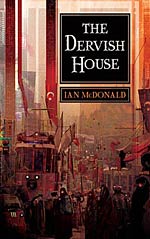
![]() couchtomoon
couchtomoon
3/25/2014
![]()
We choose our friends, not our family… but what of our neighbors? Those non-blood non-friends with whom we share geography and often nothing more, who force awkward small talk at the mailbox, whose kids' bike tires streak the driveway, who happen to be there when the ambulance arrives. We hold them in an arms-length intimacy– 'I hate cleaning after your messy pine tree, but I might need you if I sprain my ankle on my jog.' (But how many ugly pickups do you really need?)
The Dervish House is a story about neighbors: a small, diverse Istanbul community, which populates an aging, neglected plaza that once housed an order of dervishes. Its inhabitants are as varied and complex as the city itself, where a cataclysm of worlds, cultures, and ideas collide and spill over the Bosphorus strait. At Adem Dede, the dervish house, rival tea houses stare each other down, old Greek immigrants gossip and argue, an art dealer prowls for religious artifacts, a pothead hides from his family, and a precocious nine-year-old with a heart condition explores the world through his bitbots (the coolest toy ever!).
The story is both a puzzle and a layered metaphor. The dervish house is a building connected, yet disconnected. The residents are disconnected, yet connected. And the plot, despite its many threads, rumbles through with promises of cohesion and meaning. The disparate story lines aren't fooling anybody– the collision of Istanbul culture will be reflected in this small, discordant community over a week-long heatwave.
McDonald opens the story from the vantage of birds soaring over sweltering Istanbul in April 2027. A blast sounds from below, followed by silence, then alarms. The birds don't care, they're just riding the thermal currents. Then we see the same scene from the characters' perspectives: Necdet, on the bus that was bombed; Can, with his mother, feels the vibrations even though the blast is muffled by his earplugs; Georgios, a retired experimental economist hears a faint blast from his favorite tea garden; Adnan, the big money trader, notices the smoke as he shops for a condo to share with his sexy wife; and Leyla, a recent marketing grad, misses a big interview due to the traffic jam that follows the blast. The story continues this pattern of alternating perspectives building snowball momentum throughout the entire story. The tale stalls only once, briefly in the middle, as the stories of Adnan, his Ultralord friends, and Ayse, his art-dealer wife, merge into a corrupt business scam that steals the focus from the more interesting and sympathetic characters. (I just wanted more of Can's bitbot action!)
Some authors spend all of their literary effort on the first few pages, then drop the pretense once the setting and mood are established. In The Dervish House, each chapter feels like a new essay as McDonald resets the tone with reminders of the oppressive heat, the noise and smells of the overpopulated landscape, and the peripheral characters who dapple scenes with their own personalities: Aydan, the news/porn peddler; the unnamed Georgian immigrant who displays her undergarments on the roof to dry; Hizir, the djinn spirit who haunts Necdet. McDonald's writing is illustrative and lucid, without being tedious. His technique is gorgeous and captivating.
The tech is great, too. McDonald dazzles the imagination with his near-future notions of nanotechnology, neurohacking, and shape-shifting robots. No film adaptation is needed here; his world is picturesque and substantial, the movement is fluid and authentic. No amount of CGI can accomplish what McDonald's words did in my head. When Can commands "Bitbots to me!" and "Shape of a rat!" the swarms of minuscule robots collapse and combine in my mind like obedient transformers. (I keep chanting in my mind, "If anyone can, Can can!"). It's a smooth transition to this world, where Google glass is a common accessory, nanopowder is sniffed to enhance performance, and auto-piloted cars swerve around the Galatsaray football stadium during the Champions' League quarterfinal with Arsenal.
Like Istanbul, history and art ooze into the cracks of progress and not everything is near-future tech as "the clean clear light of the twenty-first century [meets] sixteenth-century shadows" (Loc 4750). The survival of a start-up nanotech company hinges on Leyla's reclamation of half a miniature Koran, and Ayse is intrigued by a million-dollar deal to find a legend. These ornamental pieces of the puzzle seem extraneous. They don't really factor into the big picture, but they are as critical to the setting as the old Greek men who sit around sipping tea and shaming immigrant women. They are all part of the lifeblood of this little neighborhood in Istanbul.
Neighborhood is the theme, after all. It's not about gas scams or terrorism. It's not about honey mummies or micrography. It's about the post-modern neighborhood, and the complexities of those geographically close, yet socially distant relationships. Fortunately, McDonald averts the potentially corny backyard BBQ ending. His characters are real and full of life, intertwined, yet independent. For a moment, their lives may intersect beyond simple location, but then life goes on. Some characters are lovable, some are not, but all of them are understandable and consistent.
The Dervish House is a marvelously exotic story that succeeds in the oft-tried, oft-failed high-tech/high-culture mashup. This is what bad reviewers and bad readers promised with The DaVinci Code. This is the The DaVinci Code for readers who deserve better.
http://couchtomoon.wordpress.com